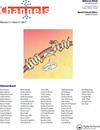渠道拆卸:挑选,调整,浸泡部分软化
IF 3.2
3区 生物学
Q2 BIOCHEMISTRY & MOLECULAR BIOLOGY
引用次数: 5
摘要
机械敏感通道是与我们宏观世界中的“机器”定义紧密匹配的分子——它们将外部机械力转化为部件的运动,以打开或关闭充满水的孔,而不涉及化学能量输入。来自大肠杆菌的细菌机械敏感通道MscL是已知的第一个,可能也是最了解的代表。膜中5对互锁的A -螺旋的极简束不需要外部蛋白质连接。桶通过螺旋倾斜和虹膜状扩张打开一个大(»3nm)孔,直接响应脂质双分子层张力。MscL的稳健性使其成为一种很有前途的模板,用于通过力或化学改性操作的工程纳米器件。已知的晶体结构和模型使分子模拟可视化脂质相互作用和作用于特定通道段的力。实验估计的打开时间尺度在微秒量级,而随后在打开状态子集内的平衡过程可能需要长达几秒的时间。试图正确表示这些随机事件的模拟至少需要这么长时间。在这个时间尺度上的原子模拟目前是无法实现的,因此需要彻底的简化。在过去的十年中,使用固态机械工程工具开发了一种有用的MscL近似方法,该方法将通道/膜系统呈现为有限弹性元件的相互作用网格。尽管表面上很简单,但MscL被溶剂和高度各向异性的双分子层包围,这两者在门控过程中都改变了它们与蛋白质的相互作用。这对有限元方法提出了几个挑战。一是必须考虑到溶剂可及面积和相关水化贡献的巨大变化。在某种程度上,最近通过明确地引入水合能学的术语来解决这个问题。有限元方法的第二个过度简化是,虽然不同元素的有效弹性可以从原子计算中得出,但它们被假设为恒定的,并且不清楚它们在不同的溶剂化或脂质内部的隔离下如何变化。巴维等人发表在本期杂志上的论文解决了这些问题。他们在定向分子动力学模拟中对MscL的孤立a-螺旋进行了弹性测试,给出了不同结构域的模量估计。正如人们所预料的那样,弹性模量值在从结核分枝杆菌切换到其模拟的大肠杆菌同源物时发生了一定程度的变化。最重要的是,与真空中的模拟相比,a-螺旋在水合状态下变得相当柔软。这一发现可能对基于连续体模型的MscL力学至关重要,因为孔隙衬里螺旋的水化作用在通道打开时急剧增加。此外,当面向脂质的螺旋在拉伸(和变薄)双分子层中倾斜时,它们的水合作用也可能发生变化。这就要求将有限元模型提升到单元对环境变化敏感并通过仿真调整刚度的模型。弹性的变化对于门控时间的过程是至关重要的,并且可能潜在地影响井流本文章由计算机程序翻译,如有差异,请以英文原文为准。
Channel disassembled: Pick, tweak, and soak parts to soften
Mechanosensitive channels are the molecules closely matching the definition of “machines” in our macroworld—they convert external mechanical forces into motion of the parts to open or close a water-filled pore, with no chemical energy inputs involved. Bacterial mechanosensitive channel MscL from E. coli is the first known and probably the best understood representative of this group. A minimalistic bundle of 5 pairs of interlocked a-helices in the membrane requires no external protein connections. The barrel responds directly to the lipid bilayer tension by tilting of the helices and iris-like expansion that opens a large (»3 nm) pore. Robustness of MscL makes it a promising template for engineering nano-devices operated by force or chemical modification. Known crystal structures and models enabled molecular simulations which visualized lipid interactions and forces acting on specific channel segments. The experimentally estimated timescale of the opening, is in the order of microsecond, whereas the process of subsequent equilibration within the subset of open states may take up to several seconds. Simulations striving for proper representation of these stochastic events must be at least as long. Atomistic simulations on this time scale are currently unattainable thus calling for radical simplifications. Over the last decade, a helpful approximation for MscL was developed using solid-state mechanical engineering tools that present the channel/membrane system as interacting meshworks of finite elastic elements. Despite the apparent simplicity, MscL is surrounded by solvent and a highly anisotropic bilayer that both change their interactions with the protein during the gating. This poses several challenges for the finiteelement approach. One is the necessity to account for large changes of the solvent-accessible area and associated hydration contribution. In part, it was recently addressed by explicitly introducing terms for the hydration energetics. The second oversimplification of the finite-element approach was that, while effective elasticities of different elements can be derived from atomistic calculations, they were assumed to be constant and it is unclear how they change under varying solvation or sequestration inside the lipid. The paper by Bavi et al. published in the current issue addresses these questions. Their elasticity tests of isolated a-helices of MscL in steered molecular dynamics simulations gave different moduli estimations for different domains. As one can expect, the elastic modulus values changed to some extent upon switching from M. tuberculosis MscL to its modeled E. coli homolog. Most importantly, the a-helices became considerably softer when the helix was hydrated, compared with simulations in vacuo. That finding might be crucial for the mechanics of MscL in continuum-based models because the hydration of the pore-lining helices increases dramatically upon channel opening. Moreover, as the lipid-facing helices tilt in the stretching (and thinning) bilayer, their hydration is likely to change too. This calls for advancement of the finite-element model to the one where elements are sensitive to the changing environment and adjust their stiffness through the simulation. The change in elasticity can be essential for the gating time course and may potentially contribute to the well-
求助全文
通过发布文献求助,成功后即可免费获取论文全文。
去求助
来源期刊

Channels
生物-生化与分子生物学
CiteScore
5.90
自引率
0.00%
发文量
21
审稿时长
6-12 weeks
期刊介绍:
Channels is an open access journal for all aspects of ion channel research. The journal publishes high quality papers that shed new light on ion channel and ion transporter/exchanger function, structure, biophysics, pharmacology, and regulation in health and disease.
Channels welcomes interdisciplinary approaches that address ion channel physiology in areas such as neuroscience, cardiovascular sciences, cancer research, endocrinology, and gastroenterology. Our aim is to foster communication among the ion channel and transporter communities and facilitate the advancement of the field.
 求助内容:
求助内容: 应助结果提醒方式:
应助结果提醒方式:


